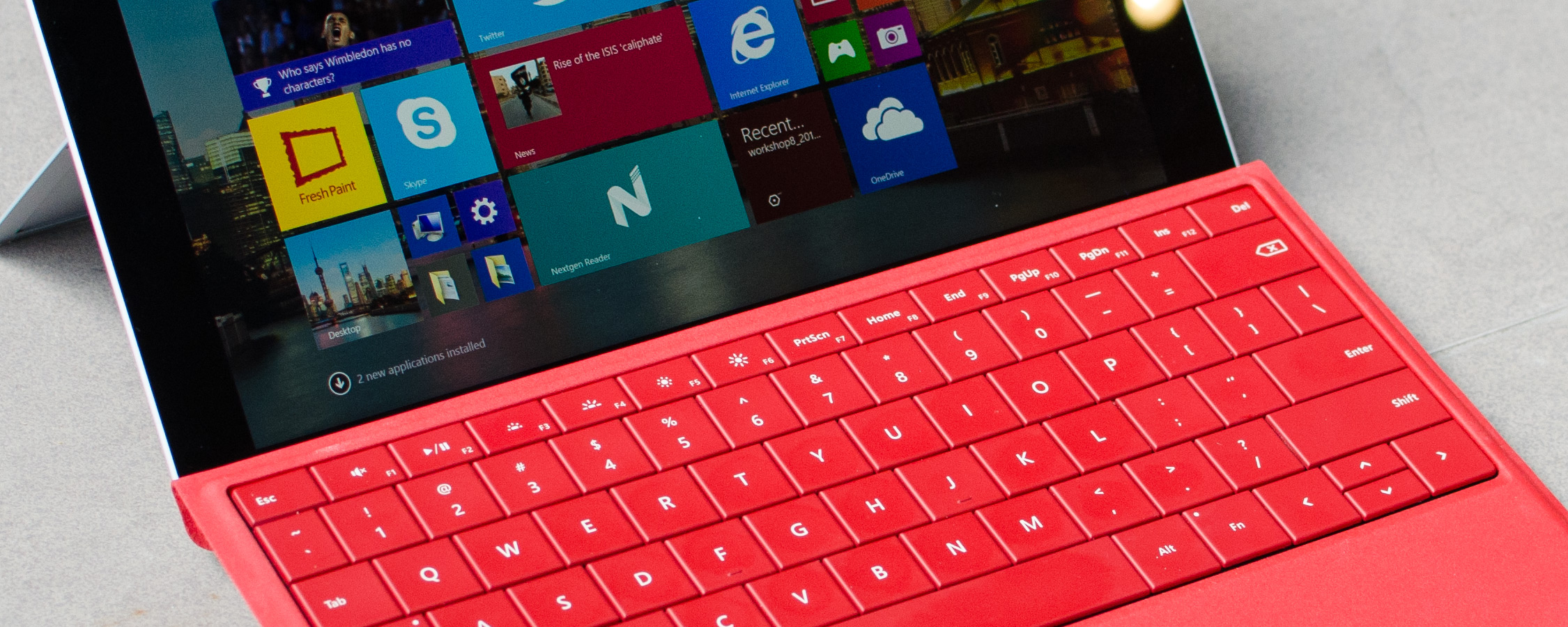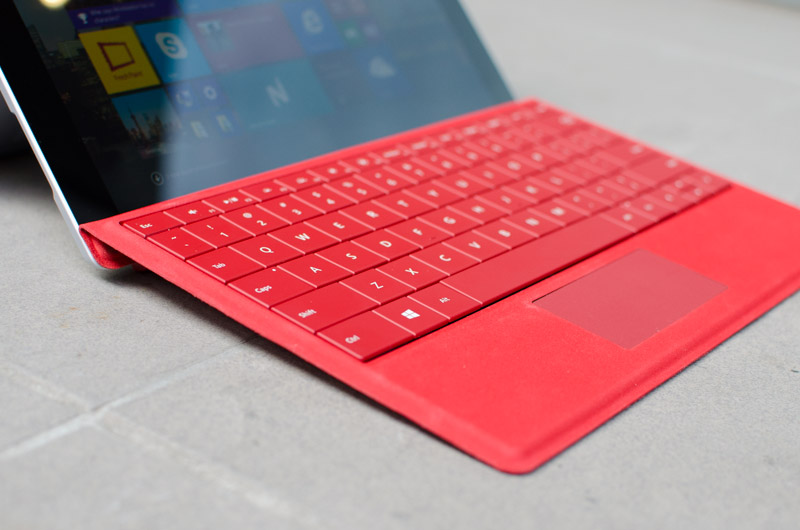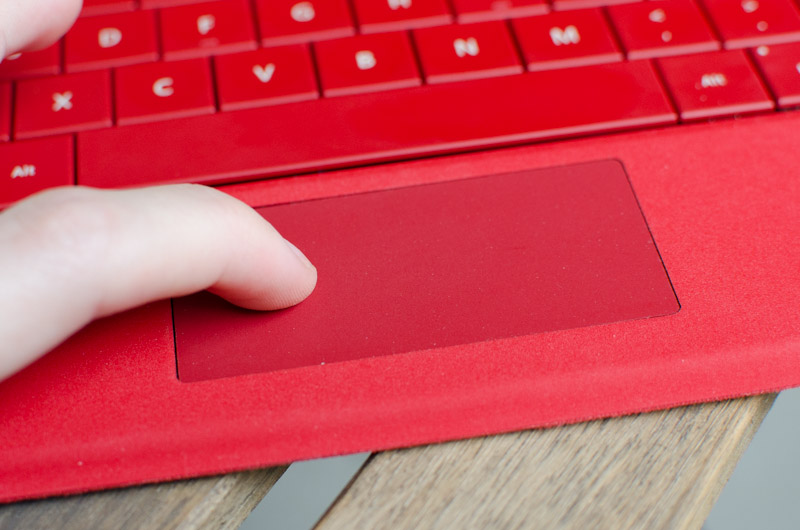Type Cover, Surface Pen: Laptop-Tablet Hybrid?
One of the best aspects of Microsoft's Surface line is the range of accessories that complement the device and make it significantly more versatile. The accessory that most people will be familiar with is the Type Cover, which Microsoft introduced with the very first Surface alongside the Touch Cover. While the Touch Cover has been discontinued (due to its rubbish typing experience), the Type Cover lives on and has been revised several times, leaving us with the version you can get for the Surface 3.
For those out there with a Surface Pro 3 and its Type Cover, the Surface 3's Type Cover will be very familiar: it really only differs in size. The Cover is the same size as the front of the Surface 3, and at just 5.2mm thick, it adds a layer of protection to the display without being bulky or annoying. Aside from the keyboard keys and the trackpad, which are plastic, the rest of the Type Cover is made from a very pleasing soft fabric that's slightly smoother on the front than the back.
Despite the thinness of the Type Cover, the typing experience is actually pretty decent. The keyboard's design is great considering the limited space available to it, with large backlit keys and a layout very similar to standard desktop keyboards making the Type Cover easy to type on without much practice. In fact, comparing the Type Cover to the mechanical desktop keyboard I used to write this article, the Cover's key spacing is very similar, which is great to see from a usability standpoint. Travel from each key is decent, at around 1.3mm, though not as good as the best laptop-style keyboards I've used.
While the Type Cover is generally great to type on, there are some aspects that I didn't like. The touchpad can come in handy for precision pointing, but it's too small for everyday use and the clicking mechanism Microsoft used is weak and unsatisfying. Ideally I would have liked to see a dedicated row of function keys as well as a row of F-keys, so that you don't need to hit the Fn key as often, but I can understand that space constraints is why this design wasn't used.
The magnetic strip that connects the Type Cover to the Surface 3 is strong yet easy to connect and disconnect, which makes it the perfect method of attachment. There's also a second magnetic strip in the Type Cover that can snap to the front of the Surface 3, raising the keyboard to assist with the typing experience. This is the same mechanism used in the Surface Pro 3's Type Cover, and it is a handy upgrade on the first generation Covers.
Another accessory that's available for the Surface 3 is the Surface Pen, which is an active stylus with pressure sensitivity and extreme accuracy, making it great for drawings and annotations. The Pen is quite large, as it needs a AAAA battery inside to function correctly, though it's still comfortable to hold and use.
The Surface Pen features three buttons: two along the shaft for erasing and right-clicking, and one on the top that will automatically open OneNote with a single click, or take a screenshot with a double click. All three buttons come in handy and it's great to have a lot of functionality available at your fingertips in this way. You do need to pair the Surface Pen with your Surface 3 via (passive) Bluetooth for the top button to work, though this process is relatively straightforward if you follow Microsoft's included instructions.
Unfortunately there's one major downside to the Surface Pen: there is absolutely nowhere on the tablet to store it. The Pen does come with a loop that you can use to attach it to a notepad, but I can see it getting lost easily without a slot on the tablet itself. Microsoft does sell a $4.99 Pen Loop that can be attached to the Type Cover, and this method of storage is effective enough, but this should really be included in the Surface Pen's box considering there is nowhere to put the pen without it.
With both the Surface Pen and a Type Cover at my disposal, along with the Surface 3 itself, I wanted to know what the tablet would be like to use as a laptop-like device for productivity tasks. The original Surface RT and the Surface 2 basically failed as a laptop-tablet hybrid due to problems with the kickstand and the Covers, so how does the Surface 3 fare?
After using the Surface 3 for a couple of weeks, it's clear to me that Microsoft's idea of a tablet with an accompanying keyboard cover is good in principle, but in actual usage it just doesn't work very well as a laptop. I'll give full credit to Microsoft where it's due, because as a tablet, the Surface 3 is awesome thanks to its nifty kickstand, the plethora of ports, and the awesome functionality of Windows itself. But the awkwardness of the kickstand-Type Cover combination just doesn't make it as good of a laptop as I've seen from docking tablet hybrids or from laptops themselves.
The issues I have with using the Surface 3 as a laptop stem mostly from the kickstand. The stand is great for using the tablet on a desk, or propping up the tablet when you want to view content hands-free. However, the lack of stand positions - there's only three available in the Surface 3 - means that you don't get the same level of fine tilt control as you get with a hinged laptop. Often the Surface 3's stand positions are perfectly fine, but at other times I wish I could position the Surface at an angle that the hinge doesn't support.
The situation is even more annoying when you realize the Surface Pro 3 has a multi-position kickstand. I don't see any reason why the Surface 3 also couldn't pack a multi-position kickstand considering one was used in a previous product. Having the Pro 3's stand would simply make the Surface 3 a better product.
I also don't think that the Surface 3 is a particularly great device to use on your lap. With standard laptops and many docking laptop-tablet hybrids I have no issue using them on my lap, but there's just something about the Surface 3's kickstand and Type Cover that makes the lap experience lackluster. I can't quite put my finger on the root causes of this feeling, though I believe it has something to do with the top-heavy nature of a tablet in this position and the absence of sturdiness in the Type Cover that makes the device feel somewhat flimsy and unsafe when being used in this way.
Whether or not Microsoft can polish this experience in a future Surface remains to be seen, but it's a lasting issue that the company hasn't managed to address properly since the original models were released.






